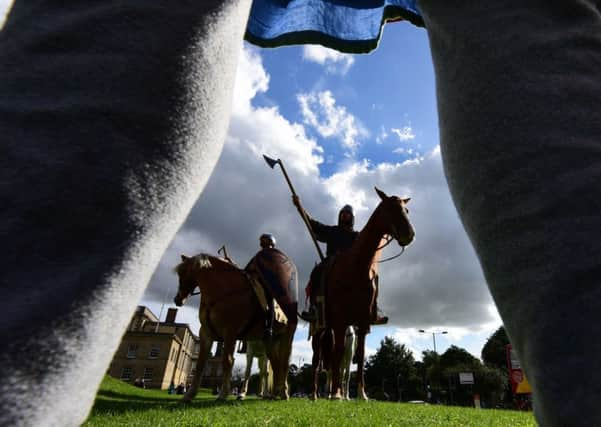Volunteer warriors retrace Harold's route and set off from York to mark 950 years since famous battle


Now a group of modern-day volunteer warriors are following in the exact footsteps of King Harold’s men as they headed to the Battle of Hastings.
The 300-mile march, to mark the 950th anniversary of the famous clash, will be made on horseback and foot from York, arriving at the East Sussex battlefield 950 years to the day after Harold fought William of Normandy.
Advertisement
Hide AdAdvertisement
Hide AdIt is part of a series of events marking the anniversary of the events of 1066 and the Norman conquest.
King Harold, the last Anglo-Saxon king of England, defeated a Viking army led by Harald Hardrada, at the Battle of Stamford Bridge, in east Yorkshire, on September 25 1066, but then had to journey swiftly south to face the Normans.
On October 14, Harold fought the Normans and was killed at the Battle of Hastings, and William seized the English throne.
The 1066 march set out from Clifford’s Tower in York, travelling through Yorkshire and the East Midlands where in Lincoln they will pass through the same Roman arch Harold and his men would have done on their journey south.
Advertisement
Hide AdAdvertisement
Hide AdThe trek, organised by English Heritage, will then travel through the Fens and to Essex, visiting Waltham Abbey where tradition says Harold may have been buried.
Marching into central London, the re-enactors will also join a pop-up Saxon encampment in Hyde Park on Saturday, October 8.
In the final week, the group will travel from Westminster into Kent and through the Weald to East Sussex, completing their version of Harold’s last journey, before arriving for the annual re-enactment of the battle.
English Heritage hopes that the march will engage communities along the route with the history of 1066, and there will be workshops with local groups and schools.
Advertisement
Hide AdAdvertisement
Hide AdNigel Amos, who is leading the march, said: “I have been involved in re-enactment for many years and for me this is a once in a lifetime opportunity.
“We do as much as we can to research the details of the history we re-enact, but there’s nothing like a personal experience like this to understand what it was like and offer an even more authentic window on that world to inspire and inform others.”
He added: “The legacy of the Norman Conquest is all around us, and for me this march is a great way of highlighting the enormity of what the people involved in the campaigns of 1066 undertook, as well as appreciating the richness of our country’s heritage, from magnificent churches and castles to Roman roads and Saxon villages hiding in plain sight.”
Also at the weekend Stamford Bridge held a show to re-enact the battle there with up to 100 Viking and Saxon warriors. Events included a special service at the memorial in the village with wreaths laid in remembrance.
Advertisement
Hide AdAdvertisement
Hide AdChris Rock, chairman of the Stamford Bridge Heritage Society, said: “When people mention Stamford Bridge they reply, ‘Chelsea Football Club’. When 1066 is mentioned, they say ‘Hastings’. We think it’s time to change that mentality.
“The nation needs to remember that of the three battles fought in 1066, two were here in Yorkshire and those two were just as bloody and just as relevant to the final outcome of 1066 as that last battle at Hastings. The Battle of Stamford Bridge Heritage Society exists to inform, educate and commemorate those men who fought and died.”
Unusual facts from Hastings
The appearance of Halley’s comet in 1066 was taken was an important omen. The Bayeux Tapestry shows the audience witnessing Harold’s coronation watching Halley’s Comet.
The Saxon and Norman armies were fairly evenly matched, which is why the battle lasted most of the day – unusually long for a medieval battle.
Advertisement
Hide AdAdvertisement
Hide AdHarold’s death is described in different ways by different sources. Some suggest that the image of an anonymous arrow falling from the heavens and striking Harold is more favourable to William than the idea of him being hacked to pieces by William’s men.
The exact location of Harold’s body is disputed to this day. You can see his alleged grave at Waltham Abbey.